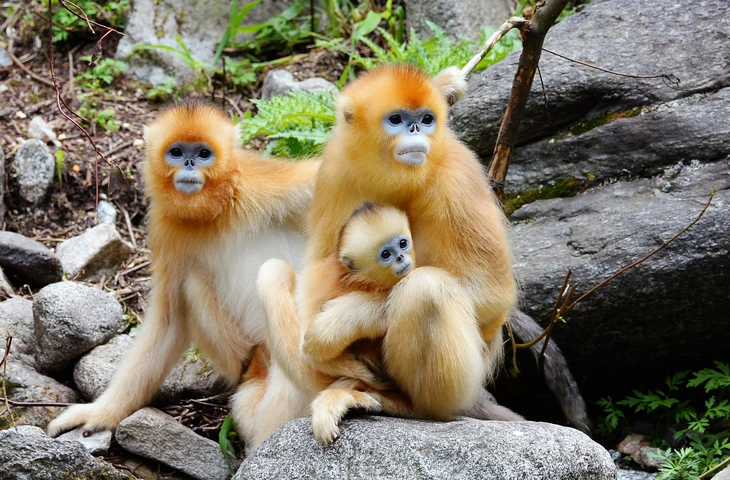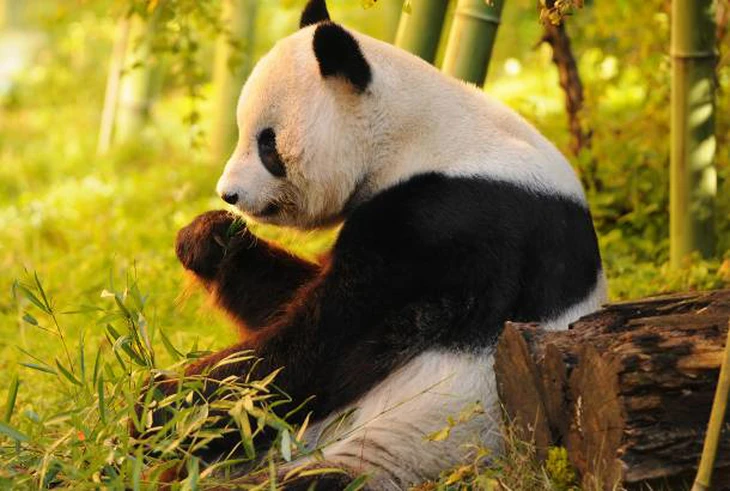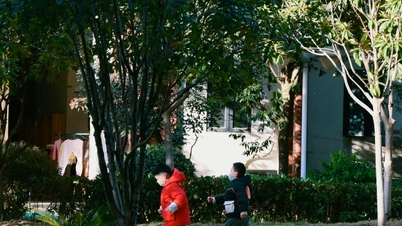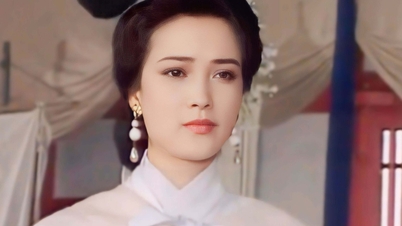
With its glossy orange fur, distinctive pale blue face, and thick fur covering both limbs, the golden snub-nosed monkey, a rare primate of China, is difficult to mistake for any other creature. - Photo: LIU XIAO/XINHUA
These golden monkey "ambassadors" have officially followed in the footsteps of pandas, becoming the next animal species that China is sending to European zoos as part of a 10-year cooperation program coordinated by the same "panda diplomacy " management team.
The 'golden-haired ambassadors'
According to NBC News, the first three golden monkeys arrived at Beauval Zoo in France in April of this year, to mark the 60th anniversary of diplomatic relations between France and China. A month later, three more arrived at Pairi Daiza Zoo in Belgium.
On the day they welcomed the special guests, Pairi Daiza handed out Chinese and Belgian flags to visitors, symbolizing bilateral friendship. After a period of quarantine, both groups of golden monkeys were introduced to the public, adapted well to the European climate, and remained healthy, according to representatives from the two zoos.
The enclosures for the three "new citizens," Liu Yun, Lu Lu, and Juan Juan, at Pairi Daiza are designed in a Chinese style, with gray tiled roofs, red pillars, and small pavilions.
The energetic golden monkeys spend much of their time climbing between wooden beams, ropes, and traditional roofs, reminiscent of the mountain villages of Hubei, their homeland.
"In a way, cultural factors have given the golden monkey added diplomatic significance," said Johan Vreys, spokesperson for Pairi Daiza.
According to Anaïs Maury, Director of Communications at Beauval Zoo, this is not just a symbolic agreement but also opens up opportunities for sustainable scientific collaboration between European zoos and Chinese researchers.
The two sides are discussing a joint research program on the biology, behavior, and conservation of giant pandas, similar to projects previously undertaken with them.
Experts believe that introducing the golden monkey, the symbol of the Shennongjia mountain range (Hubei province), to the world is not only aimed at preserving a rare species, but also represents a new generation of soft diplomacy strategy by China, building on the legacy of the highly successful "panda diplomacy" of the past several decades.
From ecological symbols, these "ambassadors" can help enhance scientific understanding, research collaboration, and cultural exchange, contributing to connecting people through a shared love for wildlife.

Giant pandas have become a soft symbol of modern China, not only because of their adorable appearance but also because of Beijing's skillful use of them in "animal diplomacy" - Photo: onthegotours
China's soft bridge
According to environmental historian Elena Songster (St. Mary's University, California), both giant pandas and golden snub-nosed monkeys are rare animals found only in China, and taking them abroad requires approval from the central government.
While the giant panda is considered a globally renowned "national treasure," the golden monkey is more deeply intertwined with Chinese art and culture.
Over the past several decades, since pandas first "entered the world," rolling, crawling, and playing in front of cameras, they quickly became a soft symbol of modern China, not only because of their adorable appearance but also because of Beijing's skillful use of them in "animal diplomacy."
The first pair of pandas, Ping Ping and Qi Qi, were gifted to the Soviet Union by China in 1957 to commemorate the 40th anniversary of the October Revolution. In 1972, following US President Richard Nixon's historic visit to Beijing, two more pandas were gifted to the United States.
Since 1984, the "gift" form has been replaced by long-term loans, each contract lasting approximately 10 years, through the China Wildlife Conservation Association.
A portion of the fees paid annually by foreign zoos goes towards habitat conservation projects or scientific research on the species. However, animal ethicists like Jeff Sebo (New York University) warn that long-distance travel and forcing the young back to China can cause significant stress to the animals, no matter how noble the goal may be.
Currently, the golden snub-nosed monkey lives in the cold mountainous regions of central and southwestern China, including Sichuan, Shaanxi, Gansu, and Hubei. Thanks to conservation efforts at Shennongjia National Park (Hubei) since the 1980s, the population has tripled, reaching approximately 1,600 individuals.
Experts believe that, in a volatile world, "furry messengers" like pandas and golden monkeys remain a soft bridge helping China maintain a friendly image.
"Pandas have become a gateway for the world to think of China in a more positive light; they are adorable, harmless, and highly symbolic," historian James Carter (Saint Joseph University, Philadelphia) observed. "Golden monkeys aren't as well-known yet, but they could become the next symbol in the future."
Source: https://tuoitre.vn/trung-quoc-tung-dai-su-long-vang-noi-got-gau-truc-20251026110523439.htm


![[Photo] Prime Minister Pham Minh Chinh receives Lao Minister of Education and Sports Thongsalith Mangnormek](/_next/image?url=https%3A%2F%2Fvphoto.vietnam.vn%2Fthumb%2F1200x675%2Fvietnam%2Fresource%2FIMAGE%2F2025%2F12%2F16%2F1765876834721_dsc-7519-jpg.webp&w=3840&q=75)
![[Photo] Prime Minister Pham Minh Chinh receives the Governor of Tochigi Province (Japan)](/_next/image?url=https%3A%2F%2Fvphoto.vietnam.vn%2Fthumb%2F1200x675%2Fvietnam%2Fresource%2FIMAGE%2F2025%2F12%2F16%2F1765892133176_dsc-8082-6425-jpg.webp&w=3840&q=75)
![[Image] Leaked images ahead of the 2025 Community Action Awards gala.](/_next/image?url=https%3A%2F%2Fvphoto.vietnam.vn%2Fthumb%2F1200x675%2Fvietnam%2Fresource%2FIMAGE%2F2025%2F12%2F16%2F1765882828720_ndo_br_thiet-ke-chua-co-ten-45-png.webp&w=3840&q=75)
![[Live] 2025 Community Action Awards Gala](/_next/image?url=https%3A%2F%2Fvphoto.vietnam.vn%2Fthumb%2F1200x675%2Fvietnam%2Fresource%2FIMAGE%2F2025%2F12%2F16%2F1765899631650_ndo_tr_z7334013144784-9f9fe10a6d63584c85aff40f2957c250-jpg.webp&w=3840&q=75)
































































![[Photo] Prime Minister Pham Minh Chinh attends the Vietnam Economic Forum 2025](https://vphoto.vietnam.vn/thumb/402x226/vietnam/resource/IMAGE/2025/12/16/1765893035503_ndo_br_dsc-8043-jpg.webp)




































Comment (0)